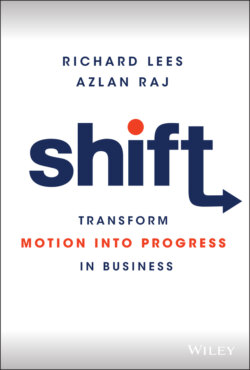Читать книгу Shift - Richard Lees - Страница 12
The race to the top
ОглавлениеOur favourite analogy to describe what a business needs to do in order to turn motion into progress is Formula 1. Behind the fast cars, daring driving, and excitement of race days there are three key components at work: the principal, the crew, and the season.
The principal of each team sets the direction and leads from the front. The crew needs to collaborate and work together to constantly improve the car, its engine performance, drive the car, and find ways to shave even 0.1 of a second off the lap time or length of a pit stop because that 0.1 second can mean the team's driver wins the race. Then there is the Formula 1 season, which lasts for much longer than a single race. Every race throughout the season is different. The car itself will perform differently depending on both the track and the weather conditions on the day, and the crew will need to adapt according to the conditions.
Figure i.1
When we apply those three principles to a business, we can see a clear correlation to core enterprise functions and challenges. The principal represents the leaders within the business, the people who make those big decisions, keep one eye on the big picture, and make sure that the company is moving in the right direction. The crew is the broader teams, the people on the ground who make things happen. When they are all aligned behind an organisation's vision, great things happen and progress begins to accelerate.
The season is the external environment that will have an impact on not only how the business performs, but also on how the team functions and performs in different situations. The season is the one element of the pyramid that the business doesn't have total control over. What any organisation can control, however, is how it responds to its environment. This becomes a game of agility, where the businesses that learn fast and adapt quickly survive, and those that don't, die.
You need to have all three components of the pyramid in place and working together in order to achieve progress. Without all of these components, your business will struggle to successfully turn motion into progress.
If you just have the principal with the season, but the crew is not aligned and engaged, you create fatigue. You will only have a short amount of time to build momentum and achieve your goals before you run out of energy.
Figure i.2
If you have the principal setting a clear direction of travel and the crew aligned behind them, but no awareness of the season and external environment, this leads to obsolescence. You won't be creating and delivering the products or services the market, and your customers, need.
Figure i.3
Finally, if the crew is responding to the season and working within the external environment, but is doing so without any leadership or direction from the principal, what you are left with is chaos. There won't be any coherence in your activities and progress will stall.
Figure i.4
What many organisations are aiming for is what we discussed at the beginning: the principal setting a clear direction and communicating the big-picture vision; the crew aligning with this vision, buying into it and being given autonomy to work toward that goal; and the organisation as a whole being aware of and having the ability to adapt to an ever-changing environment. The ideal state is to find a balance among all three themes.
Figure i.5
“The economy has fundamentally changed. We've moved from a world with digital to a digital-first world; and there's no going back. Digital has become the way for people to connect, work, learn, and be entertained and the imperative for digital customer engagement has never been greater. Every business must understand their customers to deliver personalized digital experiences.
“The brands that win this race will have hands-on leaders who are open to change, a culture built around trust, rapid decision making and action, as well as a dedication to innovation and learning. Most of the evolution we have seen through COVID-19 has centred on transactional needs, be it the global pivot to online shopping or the rise of digital finance. However, brands must also consider how these unprecedented times affect people at the cultural and emotional level.”
Paul Robson, President of Adobe International, Adobe
